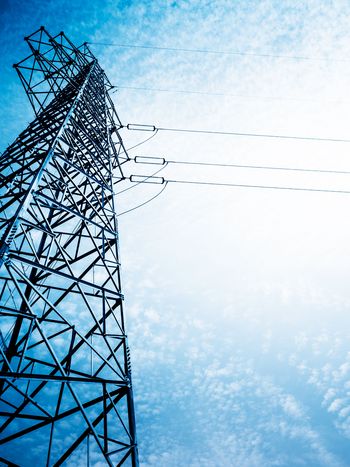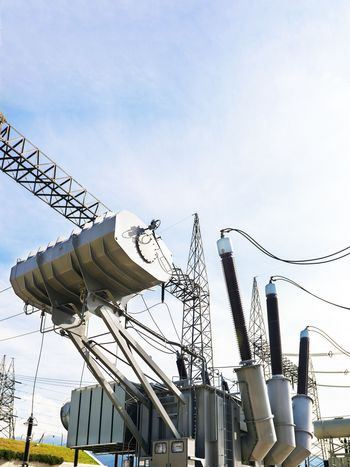Insulated Cables
by Marco Marelli, Chair & Matthieu Cabau, Secretary
What's next?
What 2020 left is at first a strong willingness to look ahead.
It is therefore normal to think about the future and to talk about the new normality that will come.
These discussions are very relevant also for CIGRE and specifically for Study Committee B1 “Insulated Cables”.
Bricks
When it comes to how to deal with new ways of working, individual experiences and best practices of people with their employers or within other organizations may become good starting points and can inspire new initiatives.
In the past year B1 members, both in Study Committee and in all Working Bodies, applied it.
It happened therefore that Working Groups meetings were scheduled more frequently, through web platforms, with meetings’ duration that was reduced to ease the participation of members from different time zones.
It happened also that tutorials that were organized in different Countries were replaced with webinars and – whenever they were in English language – allowed participation from different countries. This also increased the focus on the main webinars, organized by CIGRE Central Office, that become one of the most qualified sources of education.
It happened that very frequent and informal communication replaced the traditional meetings also for Advisory groups, particularly for the organization of all web-based events, increasing the efficiency and the efficacy of the involved teams.
All these little things will not disappear. They will rather become bricks on which to build a new way of working together for the coming years.
Among all these bricks it worth to underline some of them.
Notwithstanding a period of few months at the start of the pandemic, when Working Groups were not working smoothly as they were trying to understand the real extent of the disruption, during 2020 B1 had almost 80 working group meetings run in electronic format. Some of the WG meetings were lasting three days, but occupying just 2-3 hours per day, balancing the need to progress the WG activities with the needs of participating members. Other WG meetings were instead happening twice per day, capturing contributions from different time zones. These very different approaches were shared among Conveners, thus stimulating different approaches.
As for webinars, SC B1 had three events that were exceptionally attended:
- “Recommendations for additional testing for submarine cables from 6 kV (Um = 7.2 kV) up to 60 kV (Um = 72.5 kV)”, in January
- “Trenchless Technologies”, in May
- “Fault location on Land and Submarine cable links”, in December
All of them attracted hundreds of participants, well above average of other webinars.
This success was mainly because of the high attention given to the preparation of the events, their proper advertisement, the interesting proposed topics and the high-quality level of speakers.
Last year have seen a significant increase in the use of CIGRE KMS by B1 working bodies. The Knowledge Management System provides a private space to WGs for their collaborative works; this way of working has been found to be powerful in particular in this strange period, but the sharing practices that have been implemented will be very much important for future activities. The intensive use of the platform has been also useful in the revision cycles that are performed on the Final Reports prior to publish them as Technical Brochure, thus decreasing the “time-to-market” of the proceedings of Working Groups.
A sort of “smarter communication” permeated the activity of Advisory Groups. This reflected in better exchanges between groups within and outside B1. It is worth mentioning that the B1 Strategic Advisory Group has constant liaison with many other Study Committees, allowing to align on common topics; these connections became tighter in the past year and will create future opportunities for Joint Working Groups.
Cement
These bricks won’t stay together without some cement. And this is people.
The number of experts working in Study Committee B1 and in its Working Bodies varies according to creation and disbandment of WGs, but it is always well in excess of 400 (461 at the time of this report). In some cases, they contribute to more Working Groups, leading to more than 550 contributions in the various activities.
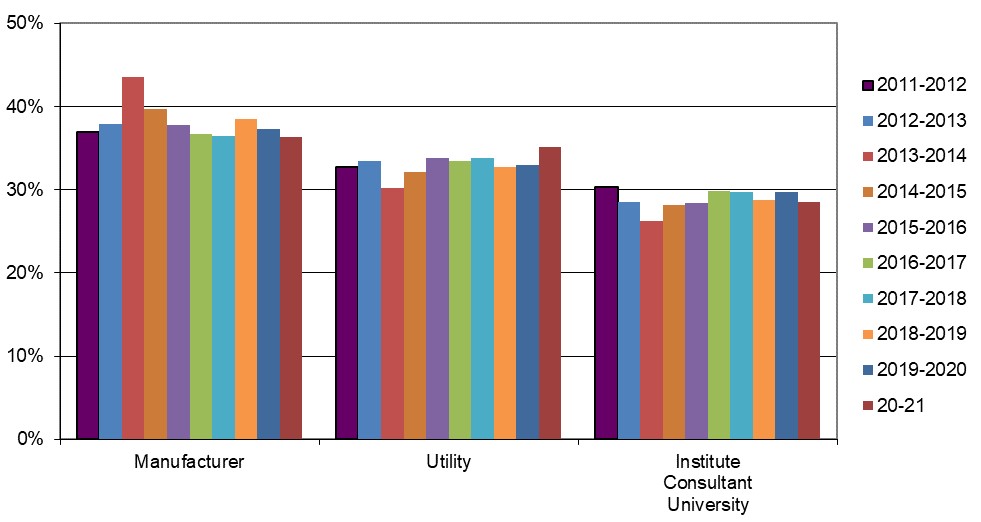
Distribution of SC B1 contributors, by employers
Excellence of SC B1 work depends also on valuing different contributions, thus diversity is important: there are representatives from all continents with a fair balance between users, vendors, academy, consultants. They have different styles, different attitudes, different ambitions, but finally converge in active support to CIGRE and its initiatives.
A big contribution in the past years was given by Alain Gille, who acted as Secretary until last August.
For this and in recognition of his outstanding participation in the activities of the technical work of the Study Committee B1, Alain received in 2020 the Technical Council Award. The importance of his activity is recognized in the words of people who promoted and sustained his candidature for this prize:
“Alain has shown in the 20 years of his participation to Study Committee B1, as Belgian Member, Working Group Member, and Secretary, his high level of expertise, competence and loyalty”;
“Without a strong and dedicated secretary who understands and can harmonize the various tasks within the Study Committee, the delivery of multiple tens of Technical Brochures in these years would have been so much more difficult”;
“And not unimportant (on the contrary!), Alain has always been very kind and helpful in the approach from person to person”.
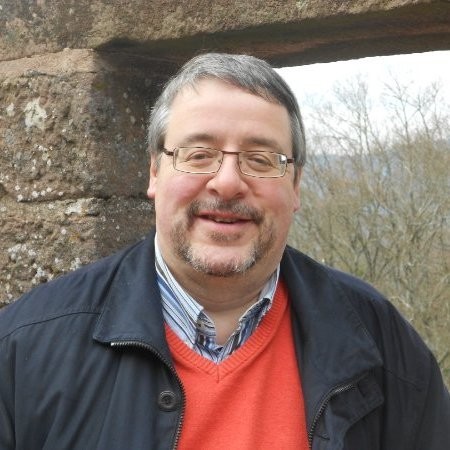
Alain Gille, SC B1 Secretary from 2012 to 2020, recognized with the TC Award
The new SC B1 Secretary, Matthieu Cabau, has therefore a significant challenge in matching and exceeding the good work done by Alain.
All together SC B1 members will continue to give attention to the evolution of the electrical system, thus supporting the evolution of the Study Committee itself.
SC B1 is committed to enlarge the focus of all activities, from the traditional high voltage (HV) and extra high voltage (EHV) transmission applications, to distribution, embedded generation and smart grids medium voltage (MV) cable system applications.
As for now, mostly driven by market evolution, HVDC and Submarine cables are getting most of the attention. Looking at the years ahead, likely they will be still taking a large share of work. Specific focus will be on quality and reliability, as well as the improvement of mechanical performances for submarine cables (deep depths, fatigue resistance and other aspects related to emerging applications).
Likewise, the extended view to higher and lower voltages than traditional scope of SC B1, aligning with the CIGRE “End-To-End” stream, will cause the need for specific works and studies on UHV in both AC and DC, along with more cooperation and coordination with other SCs to work on LV and MV, in particular for DC.
There will be also a large attention to emerging topics: increased digitalization may impact on (and may be impacted by) massive monitoring of cable systems, use of data coming from that, application of new IT technologies, including IoT.
Environmental aspects, economical aspects, accessibility, energy-for-all, technical growth, education, and everything related to sustainability will continue to play a significant role, transversally in all SC B1 activities.
Structure
Study Committee B1 is maintaining a suitable organization to deal with all those aspects.
SC B1 has therefore a Chairman (Marco Marelli, IT), a Secretary (Matthieu Cabau, FR) and – at the end of 2020 – a composition of 24 Regular Members, 13 Observer Members and 6 Additional Members that are bringing additional competences to the traditional “power transmission” background of most of Members.
The structure of CIGRE SC B1, the long term plans, the continuous addition of new energetic people, are supporting the progress in the daily work together with the four pillars that help to address the work within the “Insulated Cables” community:
- Empowerment of individuals in their contribution to Working Bodies, where they represent their respective Countries.
- Efficiency and Quality, with tough targets on the time-to-market of the works of WGs.
- Team spirit, to enjoy the unique international network of people and to have fun while working.
- Communication and local presence, encouraging all people to be ambassadors of B1 in local and international events.
A good structure is of essence to deal with the full scope of work of SC B1 that covers theory, design, applications, manufacture, installation, testing, operation, maintenance, end of life and diagnostic techniques of insulated cable systems.
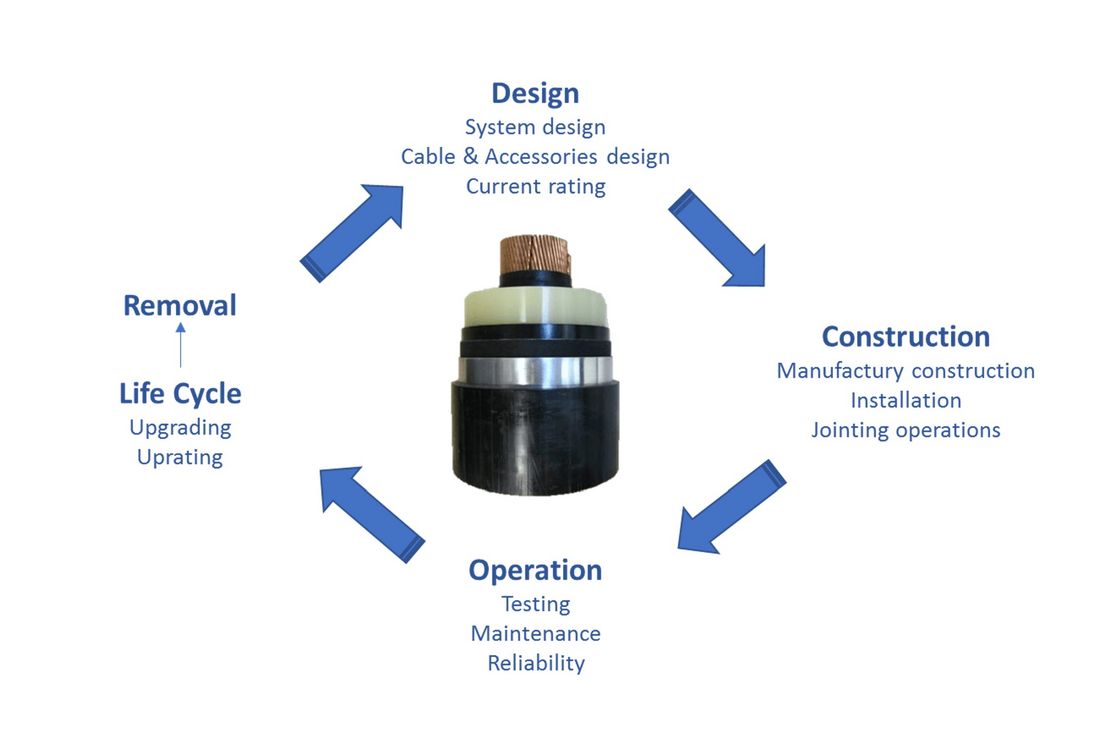
The Strategic Plan for SC B1 published in 2017 is still valid and very applicable. This document spans a period of 10 years and it is intended to define the mid to long term goals of the SC and to provide a global framework on which to base its activities.
Strategic Directions and activities of the Study Committee SC B1 are constantly aligned with strategies and guidelines coming from the Technical Council of CIGRE.
Acitivities in 2020
The most expected event of even years is – no doubts – the week in Paris, that for 2020 was replaced by the first CIGRE e-Session.
Being connected virtually to meetings and events was surely strange. Everybody was conscious of experiencing a new situation and expected subsequent difficulties in running videoconferences; this injected a common sense of support and participation that made the entire week to be a success.
Study Committee B1 activities started on Tuesday 25th of August, with the introduction for new SC National Members that usually happens in even years. The importance of this meeting, where running mechanisms of SC B1 are explained and Members’ duties are underlined, was amplified by the large number of changes. Indeed in 2020 the Study Committee changed 19 components of the 43 coming from Regular, Additional and Observer Members.
After this important administrative meeting, the first technical event for SC B1 happened on Wednesday 26th with the presentation of the Tutorial “Thermal rating and thermal monitoring of power cables”. This was delivered in the form of a webinar and have seen the active participation of over 150 attendees. The credit for the success of this lectures goes to Frank de Wild (NL) for the great work done in preparing and delivering this excellent and comprehensive set of slides and to Rusty Bascom (US) and Pieter Leemans (BE), who contributed in the presentation.
Traditionally the most important public event of the CIGRE Session is the Group Discussion Meeting. Differently from other parts of the Session, the GDM was considered too difficult to replicate in virtual format and was therefore replaced by a Paper Presentation Session that for B1 lasted 2 days, August 31st and September 1st.
For this event SC B1 confirmed Geir Clasen (NO) as Special Reporter. He was charged, together with SC Chairman, Secretary and incoming Secretary, to smoothly transit from a well-known format with prepared and spontaneous contributions, to a more guided experience but still with the aim to get active involvement of all B1 fellows.
The high quality of papers that were previously accepted for the 2020 Session allowed to have a vivid meeting. This resulted to be a combination of pre-recorded presentations of papers and live management of questions and answers.
During the two days 47 papers have been presented, including two papers selected through the CIGRE New Generation Network (NGN). These presentations showed the work of 143 authors.
Also participation to the live discussion was significantly high: over 200 people connected at least once (with an average of 130 connections at any time) and with many reported cases of “group participation”, in which people from the same organization or National Committee were sitting in a meeting room, discussing about presented contents and preparing questions for the authors.
This resulted in over 160 questions received in 2 days, with more than 120 answered verbally live during the event and the others followed up in written.
Notably, all presented papers received questions, as a further sign of the relevance of presented subjects.
Papers and live discussion will form the bases for the GDM in 2021, but also gave remarkable indications about the topics of interest for future SC B1 works.
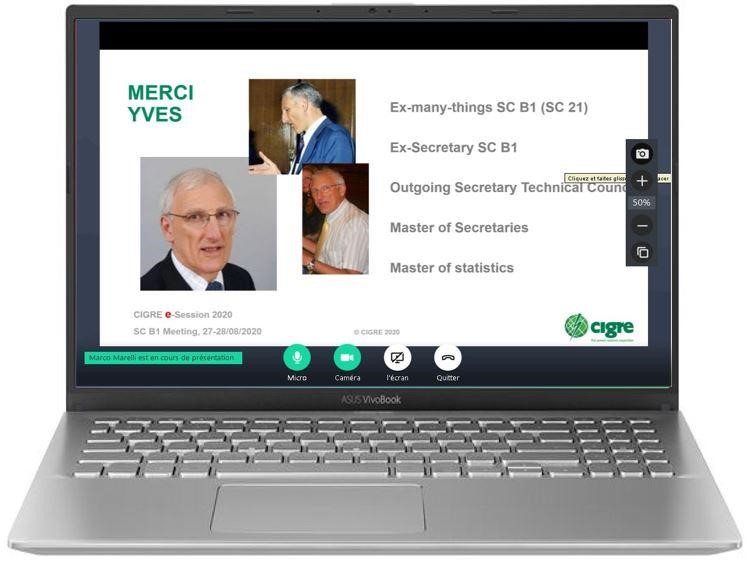
At the end of the CIGRE e-Session Yves MAUGAIN ended his term of office as Secretary of CIGRE Technical Council. SC B1 took the opportunity of the e-Session to acknowledge his support.
The format of the meeting allowed also to broadcast pre-recorded introduction and explanations of Study Committee B1 activities.
The live part was additionally the occasion to recognize the contribution of many people to SC B1 activities. This includes past officers who served as Chairmen or Secretaries and are always ready to give their support to the Study Committee.
In summary, the webinar was greatly participated, with extremely interesting contents, with professionalism, dedication, passion as ingredients from authors, organizers, attendees.
And credits go to Alain, Matthieu, Geir, Russell, Carla, Jon, Frank, Rusty, Pieter, Andre, Marc, Pierre A., Søren, Christian, Roland, Pierre M., Frode, and many others, including those from Central Office who assisted step-by-step the preparation and the management of the Poster Presentation Session.
Achievements and future works
Beside the public events, during the time of the e-Session SC B1 held its Annual Meeting.
This was the right occasion to listen to Conveners of the various Working Bodies.
Technical activities within Study Committees are indeed complex and at the end of 2020 CIGRE B1 can count 19 active Working Groups at various stages, 4 Joint Working Groups with B1 leadership, 3 Advisory Groups, 4 preparatory Task Forces. In addition, B1 is involved in several WGs and JWGs led by other Study Committees.
All Working Bodies reported therefore their progress. Despite some delay also due to the pandemic, most of WGs are doing their work with a good pace.
Four B1 Working Groups completed their work and published technical brochures in 2020 and early 2021, they are:

Other Working Groups reported that they are close to complete their work, thus expecting to publish a Technical Brochure within 2021:
| WG number | Name of the publication |
|---|---|
| WG B1.38 | After laying tests on AC and DC cable systems with new technologies |
| WG B1.56 | Cable ratings verification |
| WG B1.54 | Behavior of cable systems under large disturbances (earthquake, storm, flood, fire, landslide climate change) |
| WG B1.62 | Recommendations for testing DC extruded cable systems for power transmission at a rated voltage up to and including 800 kV |
| WG B1.66 | Recommendations for testing DC lapped cable systems for power transmission at a rated voltage up to and including 800 kV |
In addition, within the objective of disseminating the knowledge of the huge work constantly done, SC B1 reported the issue in 2020 of a CIGRE Future Connection Newsletter titled “Submarine cables, there’s power under water!”, the contribution to the Green Book “Electricity Supply Systems of the Future” and the publication of the Chinese translation of the Green Book on HV Accessories. On the same topic a new Green Book has been announced: the first volume of “Accessories for Extruded High Voltage and Extra High Voltages Cable Systems” is ready and should be published by Springer within the first half of 2021.

The Green Book is available for purchase on our partner's website Springer.
If you are a CIGRE Member, please contact us to benefit from a 40% discount on your purchase.
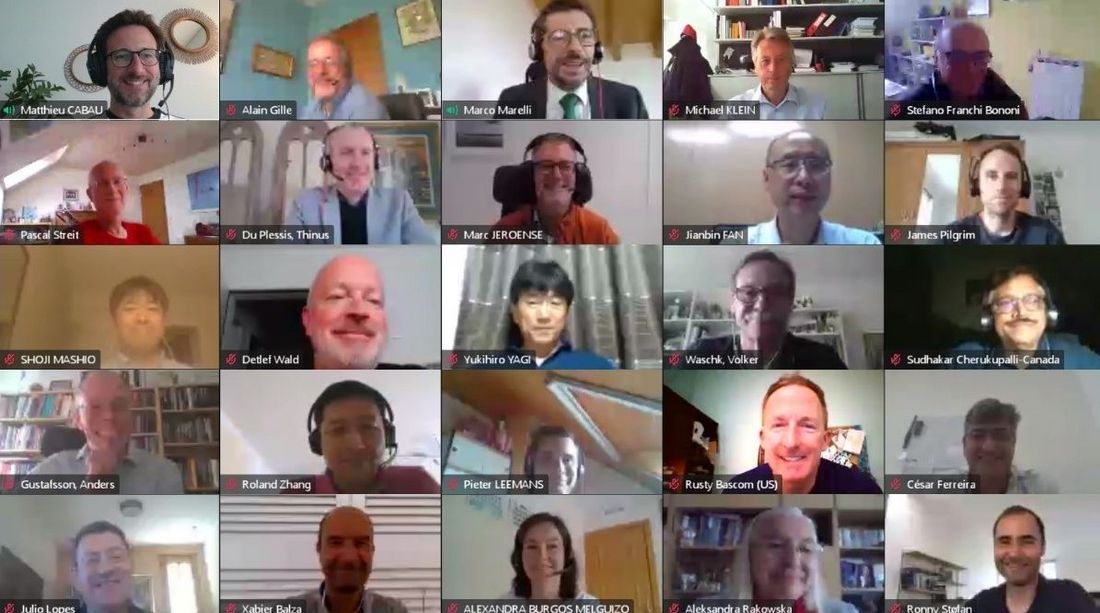
Some of participants to SC B1 annual meeting (on-line), August 2020
The Annual Study Committee Meeting was of course also the occasion to launch new works.
The new Working Groups are agreed and decided during meeting, often as a consequence of the preparatory work of dedicated Task Forces.
The proposals of New Work Items submitted to the Study Committee are prepared by the Customer Advisory Group (CAG) and formally established by the Strategic Advisory Group (SAG) of the Study Committee. Each Region of the world is represented in the CAG to gather the needs of the Regional Target Groups. At each CIGRE Session, questionnaires are proposed during the Group Discussion Meeting to identify the needs of the Target Groups of the Study Committee.
The work of Study Committee SC B1 is also kept tuned with IEC, IEEE, and other interest groups, as well as with Local and Regional Cigre organizations.
Recently CAG proposed also a dedicated email address (cigre.scb1.cag(@)gmail.com) to collect information about what are the current industry issues, what challenges are to be faced, and thus what should SC B1 be studying next.
Based on suggestions collected in first half of 2020, the following WGs were therefore discussed and launched during the SC B1 meeting:
WG B1.76: “Increasing the role of quality assurance and quality control to reduce the cable failure possibility”
The share of cables in HVAC transmission systems is increasing and more and more HVDC transmission systems ensure the availability of electrical power in an increasing number of countries. With the growing share of cable systems in our power systems, line outages generated by cable faults are more likely to lead to major parts of the grid in a critical system state. Therefore, the improved quality of cable systems as a result of the robustness of QA/QC (Quality Assurance/Quality Control) measures is of increasing importance because it directly influences the quality, reliability and availability of electrical power supply.
The WG, convened by Christian Freitag (DE), will give recommendations for QA/QC starting with the development of cable systems up to and including commissioning (supplier and supply chain evaluation, engineering, qualification, production, transportation, installation, commissioning), with a focus on (extra) high voltage cable systems for AC and DC applications.
WG B1.80: “Guidelines for Site Acceptance Test of DTS and DAS systems”
Today there are limited or no guidance or standard for Site Acceptance Test (SAT) for Distributed Temperature Sensing (DTS) and Distributed Acoustic Sensing (DAS) installations on cables, whereas this is more and more needed by end users. Factory Acceptance Tests (FAT), standardised and usually fully successful, are almost irrelevant once the DTS and DAS monitoring systems are installed on a specific site, to monitor a specific link, and expected to generate useful alarms (with no false alarm).
This Working Group, convened by Sudhakar Cherukupalli (CA), will therefore provide methods and guidance for relevant and useful SAT to verify the functionality and actual performance of the DTS and DAS systems against the specifications. The scope of these recommendation will cover land, tunnel, submarine, and long interconnector monitored cables.
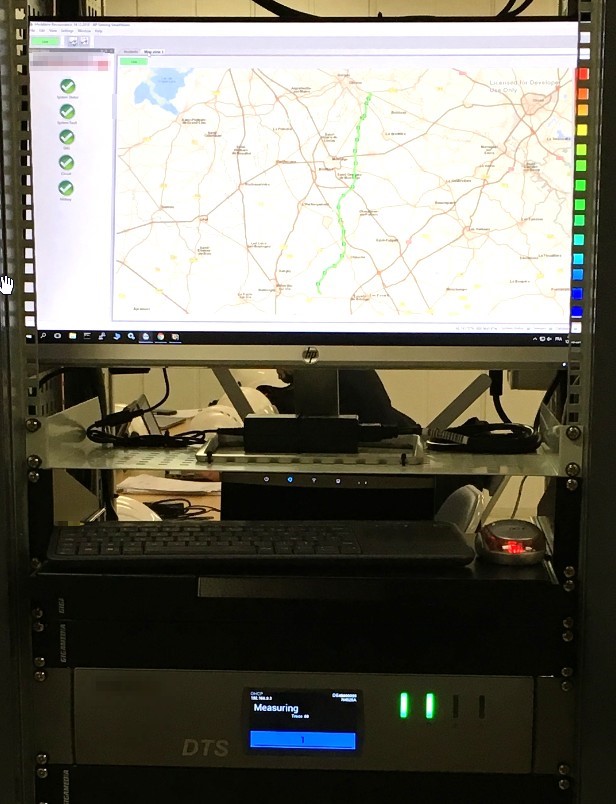
A Working Group has been debated but postponed for further discussion to 2021:
WG B1.78: “Status detection, condition monitoring and rejuvenation for power cables”
Many in-service cables are aging. As the primary cause for insulation aging and failures, water tree aging would impact the secure operation of cables by accelerating the degradation of cable insulation and potentially result in breakdown. So this WG will focus on establishing guidelines concerning aging diagnosis, water-tree locating, rejuvenation and post-rejuvenation of power cables insulation.
In addition to the described new Working Groups, during the web-meeting, Study Committee B1 decided to launch preparatory Task Forces to evaluate the need for future Working Groups on the following subjects:
- TF B1.81 : “How to have statistics every 2 years “
- TF B1.82 : “MV DC Topics”
- TF B1.83 : “Grounding aspects for long HVDC land cable connections “
- TF B1.84 : Update of IEC 60853 (cyclic and emergency current rating of cable) and IEC 62095 (Finite element method - current rating)”
These Task Forces will give their outcomes to the Study Committee Meeting in 2021 and – in case they will recommend launching Working Groups – they will propose respective Terms of Reference.

CIGRE active Working Groups / Call for experts
Happy new year!
We are experiencing a new way of working in our daily life and also in CIGRE activities. We learnt a lot from 2020. We all want to have a better and happier 2021.
The Centennial Session will be a celebration of the ingenuity of “Cigreans”. In 100 years of activity this organization helped to shape the world of electricity through technical excellence and by continuously re-inventing itself. The expected hybrid session will be a proof of the agility and the resilience of the organization. In this frame, Study Committee B1 is engaged to play its role.
The program of the week will be slightly different from past occasions, both because of the hybrid format and because of the “strange” collocation of the CIGRE week, starting on a Friday with the Opening Ceremony and lasting until a Wednesday.
Besides the Study Committee meeting, there will be three events that are expected to aggregate – in presence or from remote – experts and stakeholders of insulated cables.
The most expected happening will be the B1 Group Discussion Meeting that is going to take place on Sunday August 22nd. The discussion will be introduced through the Special Report prepared by Geir Clasen (NO). His questions – and thus relevant answers in the form of prepared and spontaneous contributions – will be around innovations and cables for future power systems, recent experiences with existing cable systems, sustainability with attention given to all aspects including environment, asset management and resiliency of cable systems.
The GDM should be preceded in the afternoon of Saturday 21st by the B1 Poster Session. This is typically where the authors of Cigre papers have the opportunity to present their work. All authors are given the equal opportunity to display their work and to communicate with interested visitors about it.
On Monday 23rd in the first part of the morning there will be the B1 Tutorial. It will be titled “Installation of HV / EHV cable links” and will be delivered by Søren Krüger Olsen (DK) and Sergio Chinosi (IT). The tutorial will present the content of some Technical Brochures recently published on this topic.
While hoping to see each other safely at the soonest, possibly in August in Paris, SC B1 members are also actively organizing local events and webinars. Aiming to stay safe and stay connected!
